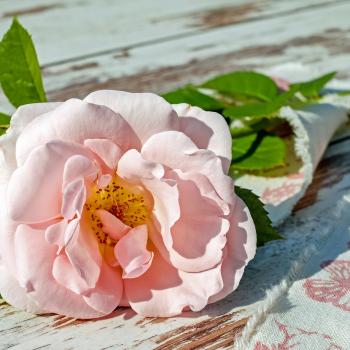I was struck by this particular line in Kate Schell’s list of modesty rules:
- Be pretty, but not too pretty.
After blogging abut Kate’s list, I blogged about a No Greater Joy article in which the author equated dressing modestly with being beautiful.
My daughters won’t dress like a strange woman either. Mine, at only 9 years old, knows that she should keep her body from a man’s eyes, reserving it for her future husband. In the grocery store one day, when my daughter was wearing a skirt that flowed around her ankles, she heard another little girl (dressed in shorts) point to my daughter and comment to her own mother, “Look, Mom, she’s beautiful!” Why not dress beautifully rather than like a slut?
Several readers called attention to this in the comments, asking whether whether dressing so as to be beautiful wasn’t immodest. Because isn’t the point of modesty as it is taught in these circles to avoid being attractive or alluring? Well, not quite, actually. And here we come to the real conundrum of modesty teachings. Do you remember the whole “Modest is Hottest” campaign? Yes, I remember it too. I was reminded of it again when watching the trailer for A Matter of Faith.
https://www.youtube.com/watch?v=zJytHdl_M1cThere, at 20 seconds, one of the male college students describes Rachel as “one of the cutest freshman we’ve seen.” Because godly evangelical girls are supposed to be modest—but also head-turningly gorgeous.
Purity advocates tend to distinguish between “sexy” and “beautiful,” and to argue that girls dressed with modesty radiate true beauty while girls dressed immodestly are “slutty” and fake. Of course, this beauty that flows from modesty is supposed to be natural and and in some sense automatic. If a modest girl works too hard to be beautiful, she may be considered vain. It’s supposed to be an inner beauty that radiates out through the girl without any effort on her part.
Purity advocates create a dichotomy of sorts:
Dressing modestly: beautiful, confident, secure, valuable
Dressing immodestly: slutty, insecure, loose, cheap, easy
You can see this dichotomy outlined in this youtube video:
https://www.youtube.com/watch?v=CJg-h6cnDrEThis dichotomy is bullshit. I dressed modestly, and yet I couldn’t have been any more insecure about my looks. I was not beautiful, either. I fell short of modesty culture’s beauty standards, and I knew it. I was dumpy, my hair never did what I wanted it to do, my face was in a constant state of outbreak, and I had a unibrow. I saw girls at church or homeschool co-op who dressed modestly and were beautiful, and I envied them. Somehow, I couldn’t meet the standard.
I was so insecure about my appearances that I put extra time into learning housekeeping and childrearing skills, determining that if I couldn’t win a guy with my looks, I would have to win him with my ability to cook a supper of chicken soup with homemade noodles and blueberry pie with homemade crust while holding a baby and deftly entertaining two toddlers. That is how insecure I was about my looks.
It’s also simply not true that girls who dress “immodestly” are insecure about their looks or their value. While there are absolutely girls who are insecure about these things, you can’t judge that from their dress. And that’s the problem, isn’t it? Purity advocates urge people to do just that—to judge girls and women by their clothing choices rather than by their personality traits or skill sets. That is what you see in the above video, when a collection of teenage boys explain that they automatically judge girls who dress “immodestly” as loose or insecure and those who dress “modestly” as valuable and confident.
But more than just this, purity culture’s twin expectations that girls both dress modestly and be radiantly beautiful set girls up for failure. I’ve heard people outside of this culture say “Isn’t it a good thing that modesty takes away some of those expectations, so that girls don’t constantly feel they have to be gorgeous and sexy?” I could see the point if it actually did take away those expectations, but it doesn’t. Modesty teachings do not communicate that girls should focus on their personality traits or skill sets rather than their looks, they simply set them on a different avenue to achieve those looks and attract the male gaze. It’s still all about looking attractive and getting the guy.
Consider these lines for a moment:
“You must dress and live for Christ in a way that radiates beauty.” (link)
“Come out and celebrate inner beauty, modesty, and vibrant purity at this Bible-based relationship-building experience for mom and their tween daughters, typically ages 8-12.” (link)
“It is the authentic beauty of modesty and virtue that He values.” (link)
“If you are confident in who you are as a child of God, that confidence will radiate to an external beauty that you won’t have to reveal by wearing revealing clothes. It’ll be obvious to anyone who looks at you.” (link)
“The apostle Peter explains the importance of modesty as a virtue that enhances the inner beauty of women.” (link)
“Women are created for beauty, created to radiate beauty to an increasingly violent and bleak world that desperately needs it. . . . Real beauty, rather than the superficial fix, is much more intoxicating.” (link)
I want my daughter to know that her value does not come from her looks. Purity culture teaches the exact opposite. In fact, purity culture ramps the idea that your value comes from your looks up to 11.














